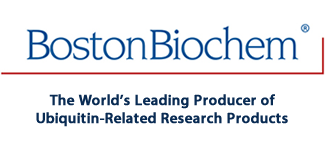
Recombinant Human CHIP/STUB1 Protein, CF Summary
Product Datasheets
Carrier Free
CF stands for Carrier Free (CF). We typically add Bovine Serum Albumin (BSA) as a carrier protein to our recombinant proteins.Adding a carrier protein enhances protein stability, increases shelf-life, and allows the recombinant protein to be stored at a more dilute concentration.The carrier free version does not contain BSA.
In general, we advise purchasing the recombinant protein with BSA for use in cell or tissue culture, or as an ELISA standard.In contrast, the carrier free protein is recommended for applications, in which the presence of BSA could interfere.
E3-220
| Formulation | X mg/ml (X μM) in50 mM HEPES pH 8.0, 100 mM NaCl, 10% Glycerol(v/v), 5 mM DTT |
| Shipping | The product is shipped with dry ice or equivalent. Upon receipt, store it immediately at the temperature recommended below. |
| Stability & Storage: | Use a manual defrost freezer and avoid repeated freeze-thaw cycles.
|
Reconstitution Calculator
Background: CHIP/STUB1
STIP1 Homology and U-box Containing Protein 1 (STUB1), also known as Carboxyl Terminus of Hsp70-interacting Protein (CHIP), is a cytoplasmic protein that functions as a U-box Ubiquitin ligase (E3) (1). It is highly expressed in striated muscle and brain and has been observed at lower levels in other organs including the pancreas, lung, liver, and kidney (2,3). STUB1/CHIP is 303 amino acids (aa) in length with a predicted molecular weight of 34.8 kDa (2). Human STUB1/CHIP shares 97% aa sequence identity with the mouse ortholog but only 67% sequence identity with the rat ortholog (2). It consists of three 34 aa N-terminal tetratricopeptide repeat (TRP) domains (aa 26-127) that are responsible for protein-protein interactions and a C-terminal U-box domain (aa 226-300) that participates in ubiquitination (1,4,5). A central domain containing charged residues lies between the TRP and U-box domains and is thought to be necessary for TRP-dependent interactions (3). STUB1/CHIP participates in intracellular protein folding/refolding and degradation. It complexes with several molecular chaperone proteins, including HSP70/HSPA1A, HSC70, and HSP90, and modulates their activity (2,3,5,6). It also facilitates the ubiquitination of chaperone substrates, including nascent CFTR, phosphorylated Tau, p53, PTEN, Synuclein-alpha, andbeta -APP, promoting their degradation (5,7-11). This recombinant human protein contains a C-terminal His6 tag.
- Jiang, J. et al. (2001) J. Biol. Chem. 276:42938.
- Ballinger, C.A. et al. (1999) Mol. Cell. Biol. 19:4535.
- McDonough, H. & C. Patterson (2003) Cell Stress Chaperones 8:303.
- Schulman, B.A. & Z.J. Chen (2005) Mol. Cell 20:653.
- Kumar, P. et al. (2012) J. Neurochem. 120:350.
- Connell, P. et al. (2001) Nat. Cell Biol. 3:93.
- Meacham, G.C. et al. (2001) Nat. Cell Biol. 3:100.
- Shin, Y. et al. (2005) J. Biol. Chem. 280:23727.
- Esser, C. et al. (2005) J. Biol. Chem. 280:27443.
- Kumar, P. et al. (2007) Hum. Mol. Genet. 16:848.
- Ahmed, S.F. et al. (2012) J. Biol. Chem. 287:15996.
Citation for Recombinant Human CHIP/STUB1 Protein, CF
R&D Systems personnel manually curate a database that contains references using R&D Systems products.The data collected includes not only links to publications in PubMed,but also provides information about sample types, species, and experimental conditions.
1Citation: Showing 1 - 1
- Syntaphilin Ubiquitination Regulates Mitochondrial Dynamics And Tumor Cell MovementsAuthors: JH Seo, E Agarwal, KG Bryant, MC Caino, ET Kim, AV Kossenkov, HY Tang, LR Languino, DI Gabrilovic, AR Cohen, DW Speicher, DC AltieriCancer Res., 2018;0(0):.Applications: Bioassay
FAQs
No product specific FAQs exist for this product, however you may
View all Proteins and Enzyme FAQsReviews for Recombinant Human CHIP/STUB1 Protein, CF
There are currently no reviews for this product. Be the first toreview Recombinant Human CHIP/STUB1 Protein, CF and earn rewards!
Have you used Recombinant Human CHIP/STUB1 Protein, CF?
Submit a review and receive an Amazon gift card.
$25/€18/£15/$25CAN/¥75 Yuan/¥1250 Yen for a review with an image
$10/€7/£6/$10 CAD/¥70 Yuan/¥1110 Yen for a review without an image
ebiomall.com






>
>
>
>
>
>
>
>
>
>
>
>
如题,之前买的sigma的粉末,太贵。加培养基又不方便
【认领须知】
1、认领翻译的战友请跟帖注明“认领本文翻译,48小时内未完成,请其他战友认领!”
2、请根据自己专业背景选择认领,如使用翻译软件翻译,被发现者扣分1-2分
3、经常认领而不能及时提供优质稿件者将被列入黑名单,取消认领资格,请大家注意!
4、翻译时请参照版规:点击查看
5、在首位认领战友未超过规定时间的其他任何认领属违规认领,将不会给予丁当或加分!
6、翻译完成后加分(或丁当)的时限为三日,请耐心等待,若超过时限未加者可进行申诉:点击进入
7、本文题目仅供译者参考,篇幅较长者可申请适当延时
8、翻译前请查一下有无重复帖
9、为保证翻译质量,每人每天最多只能认领两篇
10、链接:http://www.ascopost.com/News/48387
FDAApprovesLenalidomideasMaintenanceTherapyforPatientsWithMultipleMyelomaFollowingAutologousStemCellTransplant
OnFebruary22,theU.S.FoodandDrugAdmiNISTration(FDA)expandedtheexistingindicationforlenalidomide(Revlimid)10mgcapsulestoincludeuseforpatientswithmultiplemyelomaasmaintenancetherapyfollowingautologoushematopoieticstemcelltransplant.TheexpandedindicationmakeslenalidomidethefirstandonlytreatmenttoreceiveFDAapprovalformaintenanceusefollowingautologoushematopoieticstemcelltransplant.
“Autologousstemcelltransplantafterinductiontherapyispartofthecontinuumofcarefortransplant-eligIBLe[patientswith]multiplemyeloma.However,mostpatientswillstillseetheirdiseaserecurorprogressafterthistreatment,”saidPhilipMcCarthy,MD,Director,BloodandMarrowTransplantCenter,DepartmentofMedicineatRoswellParkCancerInstitute.“Lenalidomidemaintenancetherapy,whichhasbeenshowntoincreaseprogression-freesurvivalfollowingautologousstemcelltransplantinclinicaltrials,canbeconsideredastandardofcareforthesepatients.”
ClinicalTrialFindings
Theapprovalwasbasedontwolargestudies—CALGB100104andIFM2005-02—includingmorethan1,000patientscomparinglenalidomidemaintenancetherapygivenuntildiseaseprogressionorunacceptabletoxicityafterautologoushematopoieticstemcelltransplantvsnomaintenance.Inbothstudies,theprimaryefficacyendpointwasprogression-freesurvival.
Inthemostcurrentprogression-freesurvivalanalysis,Study1(CALGB100104)demonstratedamedianprogression-freesurvivalof5.7years(95%confidenceinterval[CI]=4.4–notestimable)vs1.9years(95%CI=1.6–2.5)fornomaintenance,adifferenceof3.8years(hazardratio[HR]=0.38;95%CI=0.28–0.50).
Study2(IFM2005-02)alsoshowedabenefitwithamedianprogression-freesurvivalof3.9years(95%CI=3.3–4.7)vs2years(95%CI=1.8–2.3)fornomaintenance,adifferenceof1.9years(HR=0.53;95%CI=0.44–0.64).
Individualstudieswerenotpoweredforanoverallsurvivalendpoint.
AdescriptiveanalysisshowedthemedianoverallsurvivalinStudy1was9.3years(95%CI=8.5–notestimable)forpatientswhoreceivedlenalidomidevs7years(95%CI=5.9–8.6)fornomaintenance(HR=0.59;95%CI=0.4–0.78).InStudy2,medianoverallsurvivalwas8.8years(95%CI=7.4–notestimable)forpatientswhoreceivedlenalidomidevs7.3years(95%CI=6.7–9.0)fornomaintenance(HR=0.90;95%CI=0.72–1.13).
AdverseEvents
Themostfrequentlyreportedadversereactionsin≥20%(lenalidomidearm)acrossbothmaintenancestudies(Study1,Study2respectively)wereneutropenia(79%,61%);thrombocytopenia(72%,24%);leukopenia(23%,32%);anemia(21%,9%);upperrespiratorytractinfection(27%,11%);bronchitis(5%,47%);nasopharyngitis(2%,35%);cough(10%,27%);gastroenteritis(0%,23%);diarrhea(55%,39%);rash(32%,8%);fatigue(23%,11%);asthenia(0%,30%);musclespasm(0%,33%);andpyrexia(8%,21%).ThemostfrequentlyreportedGrade3or4reactions(morethan20%inthelenalidomidearm)includedneutropenia,thrombocytopenia,andleukopenia.
Thefrequenciesofonsetofadversereactionsweregenerallyhighestinthefirst6monthsoftreatmentandthenthefrequenciesdecreasedovertimeorremainedstablethroughouttreatment.
Inpatientsreceivinglenalidomidemaintenancetherapy,hematologicsecondprimarymalignanciesoccurredin7.5%ofpatientscomparedto3.3%inpatientsreceivingplacebo.Theincidenceofhematologicplussolidtumor(excludingsquamouscellcarcinomaandbasalcellcarcinoma)secondprimarymalignancieswas14.9%,comparedto8.8%inpatientsreceivingplacebowithamedianfollow-upof91.5months.Nonmelanomaskincancersecondprimarymalignancies,includingsquamouscellcarcinomaandbasalcellcarcinoma,occurredin3.9%ofpatientsreceivinglenalidomidemaintenance,comparedto2.6%intheplaceboarm.
名称:氨氧基乙酸盐;羧甲氧基胺半盐酸盐;
分子式:C2H5NO3·0.5HCl
分子质量:109.30
熔点:156℃
【认领须知】
1、认领翻译的战友请跟帖注明“认领本文翻译,48小时内未完成,请其他战友认领!”
2、请根据自己专业背景选择认领,如使用翻译软件翻译,被发现者扣分1-2分
3、经常认领而不能及时提供优质稿件者将被列入黑名单,取消认领资格,请大家注意!
4、翻译时请参照版规:点击查看互
5、在首位认领战友未超过规定时间的其他任何认领属违规认领,将不会给予丁当或加分!
6、翻译完成后加分(或丁当)的时限为三日,请耐心等待,若超过时限未加者可进行申诉:点击进入
7、本文题目仅供译者参考,篇幅较长者可申请适当延时
8、翻译前请查一下有无重复帖
9、为保证翻译质量,每人每天最多只能认领两篇
10、链接:http://www.ascopost.com/News/57763
ICML2017:PhaseIIIbMAGNIFYStudyofLenalidomideandRituximabCombinationinRelapsed/RefractoryFollicularandMarginalZoneLymphoma
AninterimanalysisofMAGNIFY,aphaseIIIb,randomized,open-label,multicenterstudyoftheR2combinationregimen(lenalidomide[Revlimid]plusrituximab[Rituxan])inpatientswithrelapsedorrefractorymarginalzonelymphoma,waspresentedattheInternationalConferenceonMalignantLymphoma(ICML)inLugano,Switzerland.ThisanalysisexpandedupondatapresentedearlierinthemonthattheASCOAnnualMeeting(Abstract7502).
TheMAGNIFYstudycontinuestoevaluatetheclinicalactivityof12cyclesofR2combinationtherapyfollowedbyrandomizationtoeither18cyclesofR2maintenanceor18cyclesofrituximabmonotherapy,inpatientswithrelapsedorrefractoryfollicularlymphoma,marginalzonelymphoma,ormantlecelllymphoma.Approximately500patientsareplannedtobeenrolledinthestudy.
Theprimaryendpointisprogression-freesurvival.Secondaryendpointsincludeoverallsurvival,overallresponserate,completeresponse,improvementofresponse,durationofresponse,durationofcompleteresponse,timetonextlymphomatreatment,timetohistologictransformation,safety,andexploratoryquality-of-lifemeasures.EnrollmentintheMAGNIFYstudyisongoing.
ASCOData
AttheASCOAnnualMeeting,interimdatawerepresentedfromananalysisofasubsetofpatientsfromtheMAGNIFYstudywithrelapsedorrefractoryfollicularlymphoma(n=160)withearly-relapse(n=52)anddouble-refractory(n=50)disease.
AttheJanuary9,2017,datacutoff,the1-yearprogression-freesurvivalforallfollicularlymphomapatientswas70%,with65%fordouble-refractorypatientsand49%forearly-relapsepatients.Additionally,evaluablefollicularlymphomapatients(n=128)hadanoverallresponserateof66%withacompleteresponse/completeresponse–unconfirmedrateof38%.Fordouble-refractorypatients(n=42),overallresponseratewas45%withacompleteresponse/completeresponse–unconfirmedrateof21%andforearly-relapsepatients(n=43),overallresponseratewas47%withacompleteresponse/completeresponse–unconfirmedrateof21%.Mediandurationofresponsewasnotmetatamedianfollow-upof10.2months.
Themostcommongrade3or4adverseeventsobservedinthestudyforallfollicularlymphoma,double-refractory,andearly-relapsepatients,respectively,wereneutropenia(29%,42%,37%),fatigue(6%,4%,8%),leukopenia(5%,8%,10%),thrombocytopenia(4%,8%,4%),andlymphopenia(3%,6%,4%).
ICMLData
DatapresentedatICMLinaseparateanalysisfocusedonpatientswithmarginalzonelymphoma(n=38),includingnodalmarginalzonelymphoma(n=18),splenicmarginalzonelymphoma(n=10),andmucosa-associatedlymphoidtissuelymphoma(n=10).
Atamedianfollow-upof13.8monthsfrominitiationoftherapywiththeR2combination,evaluablepatientswithmarginalzonelymphoma(n=32)achievedanoverallresponserateof66%withacompleteresponse/completeresponse–unconfirmedrateof44%.Evaluablenodalmarginalzonelymphomapatients(n=14)hadanoverallresponserateof57%withacompleteresponse/completeresponse–unconfirmedrateof57%.Evaluablesplenicmarginalzonelymphomapatients(n=8)hadanoverallresponserateof63%withacompleteresponserateof25%;andevaluablemucosa-associatedlymphoidtissuelymphomapatients(n=10)hadanoverallresponserateof80%withacompleteresponse/completeresponse–unconfirmedrateof40%.Mediandurationofresponsewasnotreachedforanygroup.
Themostcommongrade3or4adverseeventsobservedinpatientswithmarginalzonelymphomawereneutropenia(32%),thrombocytopenia(16%),andleukopenia(11%).
“Thechemotherapy-freecombinationoflenalidomideandrituximab,withcomplementarymechanismsofactionthatarethoughttoenhanceantibodydependentcellularcytotoxicity,continuestoshowencouragingactivityandatolerablesafetyprofileinindolentlymphomas,andparticularlyindifficult-to-treatpatientsubsets,”saidDavidJ.Andorsky,MD,co–principalinvestigatorofthestudyandmedicaloncologistattheRockyMountainCancerCentersinBoulder,Colorado.“Theseresultsinpatientswhohadfailedmultipletherapiesorrelapsedearly,aswellastheactivityinmarginalzonepatientsmeritfurtherstudyinthisareaofindolentlymphoma.”
AboutMAGNIFY
MAGNIFYisaphaseIIIb,multicenter,open-labelstudyofpatientswithgrades1–3bortransformedfollicularlymphoma,marginalzonelymphoma,ormantlecelllymphomawhoreceivedatleast1priortherapyandhadstageI–IV,measurabledisease.Approximately500patientsareplannedforenrollmentin12cyclesofR2induction,withaprojected314patientswithatleaststablediseaseafterinductionrandomized(1:1)to2maintenancearms.
Inductionincludesorallenalidomideat20mg/d,days1–21per28-daycycle(d1–21/28)plusintravenousrituximabat375mg/m2,days1,8,15,and22ofcycle1andday1ofcycles3,5,7,9,and11(28-daycycles).Patientsarethenrandomizedtomaintenancelenalidomideat10mg/d,days1to21/28,cycles13to30,plusrituximabat375mg/m2,day1ofcycles13,15,17,19,21,23,25,27,and29(R2,armA),orrituximabalone(sameschedule,armB).PatientsreceivingR2maintenanceafter18cyclesmaycontinuemaintenancelenalidomidemonotherapyat10mg/d,days1–21/28(perpatientand/orinvestigatordiscretion),untildiseaseprogressionastolerated.Patientswillbefollowedfor≥5yearsafterthelastpatientinitiatesinductiontherapy.
【认领须知】
1、认领翻译的战友请跟帖注明“认领本文翻译,48小时内未完成,请其他战友认领!”
2、请根据自己专业背景选择认领,如使用翻译软件翻译,被发现者扣分1-2分
3、经常认领而不能及时提供优质稿件者将被列入黑名单,取消认领资格,请大家注意!
4、翻译时请参照版规:点击查看
5、在首位认领战友未超过规定时间的其他任何认领属违规认领,将不会给予丁当或加分!
6、翻译完成后加分(或丁当)的时限为三日,请耐心等待,若超过时限未加者可进行申诉:点击进入
7、本文题目仅供译者参考,篇幅较长者可申请适当延时
8、翻译前请查一下有无重复帖
9、为保证翻译质量,每人每天最多只能认领两篇
原文链接:http://www.ascopost.com/News/40561
AdditionofIxazomibtoLenalidomide/DexamethasoneImprovesProgression-FreeSurvivalinRelapsed/RefractoryMultipleMyeloma
Moreauetalfoundthataddingtheoralproteasomeinhibitorixazomib(Ninlaro)tolenalidomide(Revlimid)anddexamethasonesignificantlyprolongedprogression-freesurvivalamongpatientswithrelapsed,refractory,orrelapsedandrefractorymultiplemyeloma.TheyreportedthefindingsfromthephaseIIITOURMALINE-MM1trialinTheNewEnglandJournalofMedicine.ThetrialsupportedtherecentU.S.FoodandDrugAdmiNISTration(FDA)approvalofixazomibinpreviouslytreatedmultiplemyeloma,makingitthefirstapprovedoralproteasomeinhibitor.
StudyDetails
Inthedouble-blindtrial,722patientsfrom147sitesin26countrieswererandomizedbetweenAugust2012andMay272014toreceiveixazomib(n=360)orplacebo(n=362)pluslenalidomideanddexamethasone.Treatmentconsistedof28-daycyclesoforalixazomibat4mgorplaceboondays1,8,and15;orallenalidomideat25mgondays1through21(10mginthosewithcreatinineclearance≤60or≤50mL/min/1.73m2accordingtolocalprescribinginformation);andoraldexamethasoneat40mgondays1,8,15,and22.Theprimaryendpointwasprogression-freesurvival.
Fortheixazomibvsplacebogroups,medianagewas66yearsinboth(53%vs51%>65years);58%vs56%weremale;86%vs83%werewhite;EasternCooperativeOncologyGroupperformancestatuswas0or1in95%vs93%;InternationalStagingSystem(ISS)stagewasIin63%vs64%,IIin25%vs24%,andIIIin12%inboth;78%vs72%hadcreatinineclearance≥60mL/min/1.73m2;55%vs60%hadstandard-and21%vs17%hadhigh-riskcytogenetics;numberofpriortherapieswas1in62%vs60%,2in27%vs31%,and3in11%vs9%;59%vs55%hadpriorstemcelltransplantation;diseasecategorywasrelapsedin77%inboth,refractoryin12%vs11%,relapsedandrefractoryin11%vs12%,andprimaryrefractoryin7%vs6%;priorproteasomeinhibitortherapywasbortezomib(Velcade)in69%inbothandcarfilzomib(Kyprolis)in<1%vs1%,with1%vs2%ofpatientshavingdiseaserefractorytopriortreatment;andpriorimmunomodulatorytherapywaslenalidomidein54%vs56%andthalidomide(Thalomid)in44%vs47%,with21%vs25%havingdiseaserefractorytopriortherapy.
ImprovedProgression-FreeSurvival
Aftermedianfollow-upof14.7months,medianprogression-freesurvivalwas20.6monthsintheixazomibgroupvs14.7monthsintheplacebogroup(hazardratio[HR]=0.74,P=.01).Benefitofixazomibwasconsistentacrossprespecifiedsubgroups,includingpoor-prognosissubgroupssuchasthosewithhigh-riskcytogenetics(24.1vs9.7months,HR=0.54),ISSstageIIIdisease(18.4vs10.1months,HR=0.72),thoseaged>75years(18.5vs13.1months,HR=0.87),andthosewhohadreceivedtwo(17.5vs14.1months,HR=0.75)orthree(notestimablevs10.2months,HR=0.37)priortherapies.
Overallresponserateswere78%vs72%,withtheratesofcompleteresponseplusverygoodpartialresponseof48%vs39%.Mediantimetoresponsewas1.1vs1.9months.Mediandurationofresponsewas20.5vs15.0months.Atmedianfollow-upofapproximately23months,medianoverallsurvivalhadnotbeenreachedineithergroup.
AdverseEvents
Adverseeventsof≥grade3occurredin74%oftheixazomibgroupvs69%oftheplacebogroup,withthemostcommonintheixazomibgroupbeingneutropenia(23%vs24%)andthrombocytopenia(19%vs9%).Rashofanygradewasmorecommonintheixazomibgroup(36%vs23%),asweregastrointestinaladverseevents(mostlylowgrade);22%ofixazomibpatientsand19%ofplacebopatientsreceivedantidiarrhealagents,and21%and13%receivedantiemeticdrugs.Peripheralneuropathyofanygradeoccurredin27%vs22%(grade3in2%ineach).
Seriousadverseeventsoccurredin47%vs49%.Adverseeventsledtodosereductionofanydrugin56%vs50%,discontinuationofanydrugin25%vs20%,anddiscontinuationofthestudyregimenin17%vs14%.Deathoccurredduringthestudyperiodin4%vs6%.
Theinvestigatorsconcluded:“Theadditionofixazomibtoaregimenoflenalidomideanddexamethasonewasassociatedwithsignificantlylongerprogression-freesurvival;theadditionaltoxiceffectswiththisall-oralregimenwerelimited.”









